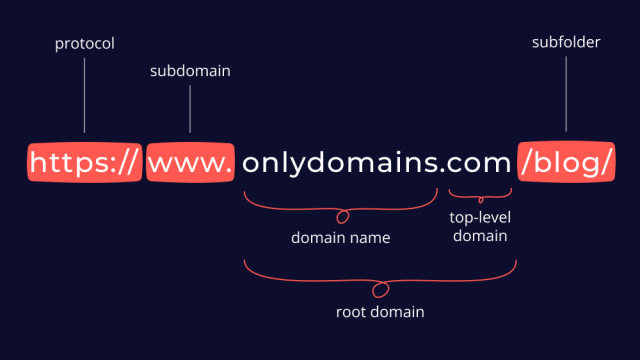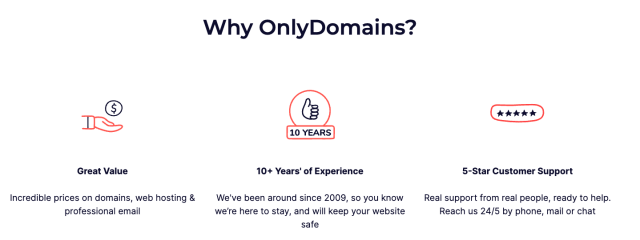What Is .com? Understand the Meaning of the World’s Most Popular Top-Level Domain Name
Have you ever looked at an Internet address and wondered, ‘what is .com?’. You may have heard talk of ‘.com businesses’ on the news or even ‘the .com crash’. In fact, if you spend any time browsing the Internet, whether ordering, shopping or catching up on current affairs, you’re likely to come across it again and again.
So, why the ubiquity of the .com domain? Why do so many businesses use .com for their websites? And, if you’re setting up a new website, why might it be the best choice for your business?
.com Meaning: What Is It Exactly and What Is It Short For?
What does .com stand for? In short, it stands for ‘commercial’, suggesting that websites using it belong to commercial organisations. But what is its broader significance?
To understand this, we need to talk about domains. Let’s briefly look at the anatomy of an Internet address. The URL (‘unique resource locator’) of the webpage hosting this article looks something like this:
- protocol: This is usually either http:// or https:// and indicates to the web browser that a web address will follow.
- subdomain: Often www., and the section that comes before the main domain name in the URL. A domain extension to create an organised directory for a different website area.
- domain name: The text form of the IP address that is more human-friendly and simple to remember. The part of the URL often used for organisation branding.
- top-level domain: The TLD, commonly called the Internet domain extension, is the last section of an Internet domain name, coming after the last dot, to complete a domain name.
- subfolder: Section helping people and web crawlers understand which particular section of a webpage they’re visiting.
- root domain: An address that corresponds to the domain name and can be used to access any page on the website.

Of course, each element of the URL plays an important role, but we will only focus on the root domain part in this article. And, in particular, we’ll zoom in on the importance of just one particular component: that little top-level domain.
First, it’s worth noting that these are usually known by the abbreviation ‘TLD’. (And they’re also sometimes referred to as ‘domain extensions’ or ‘domain suffixes’.)
There are many TLDs besides .com. Common ones you’ve probably come across include .net, .org, and .edu. Plus, there are also TLDs associated with specific countries and territories, for example, .uk (United Kingdom) and .nz (New Zealand).
And, especially in recent years, there has been a proliferation of more niche alternatives for businesses to consider: .design, .store, .info, .site, and .me (to name just a handful).
But what do these TLDs do? Well, we can summarise their significance in three ways.
- First, they perform a technical function – as part of the root domain. This provides the address of your website address. It plays a crucial role in letting users connect to the right host (and so access the website they are after).
Your root domain stakes out your space on the Internet. Every webpage on your website will fall within this root domain. And the TLD is an important part of that data navigation system.
- Second, TLDs emerged (in the early days of the Internet) to provide a rough classification structure for the vast number of websites being added. The idea was that, by looking at the top-level domain of a website, a user could guess what it’s about.
For example, ‘.com’ came to be used by commercial sites (businesses), ‘.org’ by non-profit organisations, and ‘.edu’ by educational sites.
Some TLDs are carefully regulated as classifiers. For example, ‘.gov’, ‘.mil’, and ‘.int’. Plus, some country-specific TLDs are regulated in ways that give them more currency (especially to local users) .sg and .com.au, for example.
Over time, however, the majority of TLDs have become much looser and open to anyone. So, businesses have quite a lot of choice, and that can be useful. You can choose a TLD that suits your business. What’s more, if the domain name you want is taken in one TLD, you may find it still available via a different TLD.
However, the TLDs themselves have evolved in different ways – developing characters, reputations, and connotations of their own. Businesses must consider these when choosing between them.
- Finally, for most businesses, your root domain (including the TLD) is also your website’s homepage. It acts as a gateway to everything else on your site, and you’ll direct people there to find out about your business.
In this way, it becomes a critical business marketing tool: you’ll want to get it out there and known. After all, that’s the whole point of your website.
The domain name will usually be the name of your business or a close derivative of it. But you’ll also need to choose your TLD. And that, in turn, may have a bearing on your domain name. For example, your desired name may be available on one domain but not on another.
Plus, the TLD matters inherently. It should help the entire root domain stick in people’s minds – for the right reasons. Not least, rhythmically: “Visit us at catchywebsite.com!” The TLD (‘.com’) becomes part of the music of your marketing. It must flow and fit, even to someone reading it in their head.
Moreover, these TLDs have organic reputations of their own, so you need to think of the connotations of your own for your target audience. How might your TLD nudge people’s perception of your brand?
That little top-level domain label not only serves an under-the-bonnet role – which most of us don’t need to worry about – but also a significant marketing role.
So, now you know the definition of .com, given all the TLDs available to choose from, is it still a good choice?
Why .com? Don’t Be Lost in the Fog: The Differences Between the Most Popular Domain Suffixes
With well over a thousand TLDs to choose from, let’s consider the challenges, benefits, and nuances of some of the most popular.
.com
This is, by far and away, the dominant worldwide TLD. It is hard to be definite about its reach, but most estimates suggest that nearly half of the websites worldwide use the .com suffix.
It is the one most people think of by default and has become almost synonymous with the Web itself. We’ve been hearing it and typing it into our browsers for years now. It’s ingrained in our behaviour. If we’re not sure of a website’s TLD, we’ll often assume .com and try that first.
Many of the biggest brand names use it, so users are in good company. And it’s global, meaning it’s good to go pretty much wherever you operate.
So, it’s advisable to always consider .com first. It’s a solid, familiar, and safe option. The only exception might be if you’re aiming to establish a very territory-specific image (see ccTLDs below) or if you feel a newer, more niche TLD might fit your business.
Check If Your .com Is Available
And there’s also another snag. Because of its popularity, you may find that your chosen domain name is not available as ‘.com’. In that case, you have two options:
- Adjust your domain name to one that is available as .com.
- Stick with your desired domain name but in an alternative TLD.
The truth is, you absolutely can succeed using a range of TLDs beyond .com. However, if a competitor in your sector is using your chosen domain name in the .com TLD, you may want to rethink things anyway.
.org
This TLD was created to denote non-profit organisations. Nowadays, though, it is open to anyone to use. That said, it is still most popular (and associated with) charities, political groups, religious and social organisations, and online communities.
Like .com, it is a long-established TLD, and familiarity is high (especially as many very famous organisations use it.) At the same time, it is less commonplace than .com, increasing the odds that your desired domain name will be available.
However, most people don’t associate it with shops, businesses, and commercial brands. If you are a commercial brand, using this TLD may feel a little incongruous or confusing for customers. Having said that, some do.
.net
This is another open TLD (anyone can use it) that has been around for a long time. Because of the connotations that ‘net’ evokes, it is especially popular (and associated with) digital and technology brands.
If that describes your business and .com is taken, it may be a good choice. If you’re comparing .com vs .net, remember that .com isn’t always the best option. After all, lots of well-known technology brands do very well with .net.
Country code top-level domain (ccTLD) names
Every country has a two-letter country-code top-level domain (ccTLD). So, for example, you have ‘.uk’ (United Kingdom), ‘.au’ (Australia), ‘.fr’ (France), ‘.br’ (Brazil), ‘.mn’ (Mongolia), and so on.
Consider these if your business is more local than global, and operates only in your own particular territory. A ccTLD can foster an impression of local relevance and authenticity, improving engagement with your local audience. Search engines try to provide users with localised results, so a ccTLD can boost your SEO locally. Plus, they can be cheaper to register.
However, the currency of the various ccTLDs does vary. Research shows that Australia’s ‘.au’ domain is very highly regarded in that market, for example, and helps nurture engagement. If you’re a business operating predominantly in Australia and are weighing up .com vs .com.au, the latter offers huge advantages. It is strictly regulated, so trusted even more by Australian consumers.
However, on the other hand, the ‘.us’ of the USA is used much less and appears to give less benefits: ‘.com’ is more powerful in this market.
Newer niche TLD names
Finally, there are lots of other open TLDs available. Back in the 1980s, there were only five TLDs. Now, there are over 1,500 of them.
New generic TLDs (gTLD) increased choices when registering and creating websites. More domains meant registrars were able to offer more competitive pricing. And choice created new branding opportunities for businesses, with the rise of more unique sector-specific TLDs like ‘.design’ (for graphic art and fashion), ‘.io’ (tech start-ups), and ‘.store’ (for retail businesses).
You may well find a gTLD that fits your business. Moreover, your chosen domain name may be available in it, and it may have a good ring. These newer, fresher gTLDs, like ‘.store,’ offer a genuine opportunity to create a unique identity. So, in a .com vs .store comparison, for example, both may offer you advantages.
That can all be great, but care is needed. These TLDs are much younger, and people are less familiar with them. Depending on your target market, that can be a risk. Customers can be wary of, or just confused by, unfamiliarity.
Some TLDs also have less positive connotations. For example, a few are becoming associated with spam and fraud. Just be sure to do your research. Check out the Spamhaus Project, which shows how much dirty business each TLD is seen as doing.
Is .com a Reliable Choice For Your Business?
Yes, .com is a reliable choice for your business. If your domain name is available using .com, you’re on solid ground using it.
What kind of business websites use .com, and why it is popular
A vast range of businesses use .com, from the largest corporations (like Amazon and Google) to the smallest start-ups.
As the oldest, most established, and most well-known TLD, it scores highly for credibility and trustworthiness. A customer will accept a .com address without question, but a less familiar TLD may raise a question mark.
It’s easy for customers to hear, say, and remember .com addresses (and to type them in their search engine). Other TLDs can sound a bit clunky by comparison. Less well-known ones can be misremembered or mistyped.
And .com has a global reach and reputation. You can more easily and consistently engage customers all over the world. Other TLDs may have more patchy recognition and currency.
That said, you may benefit from more than one domain for your business. As well as securing mybrand.com, consider getting your domain name in a range of other TLDs. This protects your brand (from both competitors and squatters) and gives you options to use the alternative TLD versions creatively in your marketing. Plus, you can always drive more traffic to your website by redirecting from the alternatives.
Is a .com domain extension better for SEO?
A .com domain extension is generally considered better for SEO than many of its alternatives. As the oldest, most established, and most popular domain extension, search engines tend to treat .com content as more authoritative. And some say that helps push the content further up the search results.
Of course, many criteria impact search engine result rankings. The quality of your content, backlinks, and use of keywords are all of paramount importance. Thus, your content can succeed in these respects regardless of your TLD. However, it is considered helpful to have a .com presence.
So, How Much Does a .com Domain Cost?
The cost of a .com domain varies depending on the registrar you use. However, they mostly range between around $10 and $20 per year.
OnlyDomains offers reputable service and competitive pricing for registering a .com domain name. For example, they charge a $10.99 registration fee for the first year and a renewal fee of $14.99.
How to Get a .com For Your Business Website: Start With an Experienced Domain Management Solution
The reputation and reach of the .com domain can help ensure that your website doesn’t get lost in the fog. If your desired domain name is available as .com, it’s a very safe bet.
Registering website domains can be confusing if you’re new to it. That’s why it’s worth looking at how OnlyDomains can help you on your way. With fantastic customer support, competitive pricing, and a range of options and features to choose from, OnlyDomains makes website registration simple and quick.


